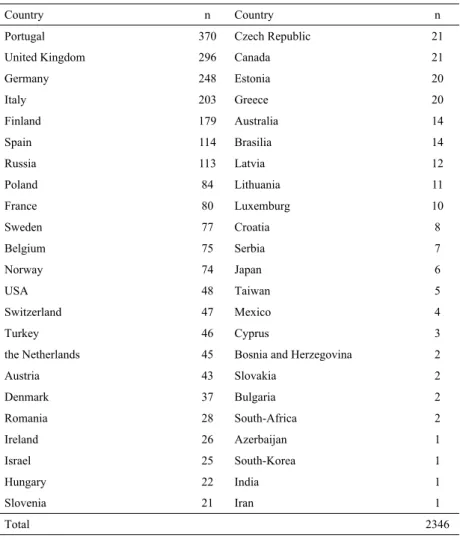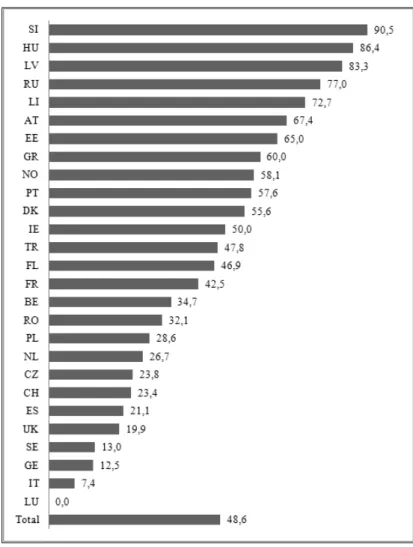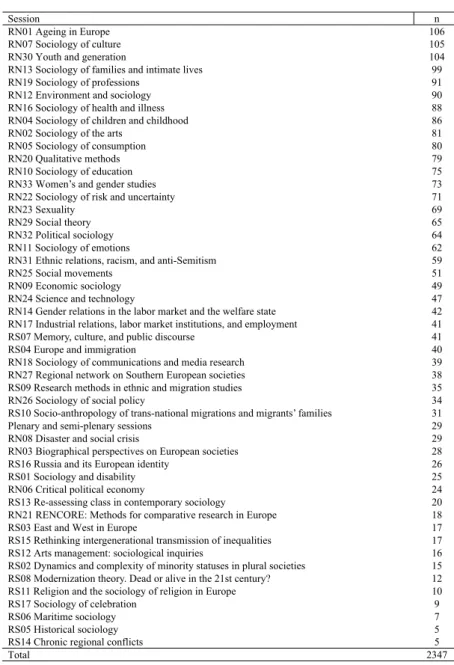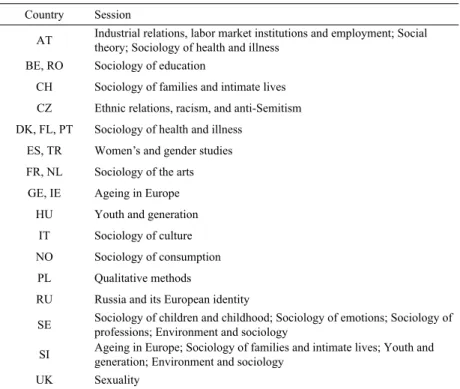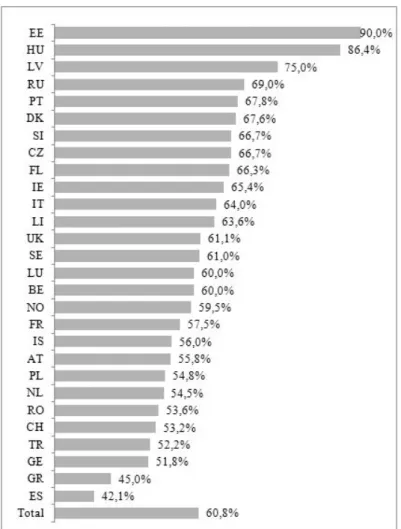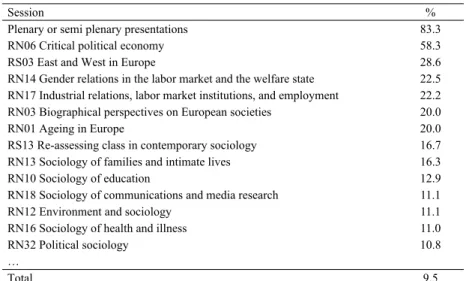CORVINUS JOURNAL OF SOCIOLOGY AND SOCIAL POLICY 1 (2010)
THE 9
THCONFERENCE OF THE EUROPEAN SOCIOLOGICAL ASSOCIATION: EUROPEAN SOCIOLOGY OR EUROPEAN SOCIOLOGIES?
LÍVIA MURINKÓ1–IVETT SZALMA2
The European Sociological Association (ESA) is a non-profit, Europe- wide academic organization with over 1,500 members. It aims at facilitating
“European sociological research, teaching and communication between sociologists and between sociologists and other scientists” (ESA 2009).
The association was established in Vienna in 1992, at the first European sociological conference.
The latest biennial ESA conference was held in the Portuguese capital of Lisbon, between September 2-5, 2009. The main question of the conference was whether we can look at European society as an increasingly cohesive entity or whether divisions of nation, class, ethnicity, region, gender, and so on continue to be more salient. Is there one European society or are there many European societies? Is the nation-state the most appropriate unit of analysis or are other approaches needed?
Is there convergence or divergence between the regions of Europe? A particular focus of the conference was the role of sociology in understanding the European area and how sociologists from different countries and with different traditions can work together toward this end.
The aim of our analysis is to provide a special description of contemporary European sociology, based on the presentations of the 9th ESA conference.
We will examine to what extent European sociological life is homogeneous, how it is structured, and which subjects attract major research attention.
The analysis is based on a database compiled by the authors of the present
1 Lívia Murinkó is a research fellow, at the HCSO Demographic Research Institute, and a PhD-candidate at the Sociology Doctoral School, Corvinus University of Budapest; e-mail:
murinko_livia@yahoo.com, murinko@demografia.hu
2 Ivett Szalma is a research fellow at the Institute of Sociology of the Hungarian Academy of Sciences, and a PhD-candidate at the Sociology Doctoral School, Corvinus University of Budapest; e-mail: szalma@socio.mta.hu
murinko-szalma.indd 123
murinko-szalma.indd 123 2010.06.29. 10:02:462010.06.29. 10:02:46
CORVINUS JOURNAL OF SOCIOLOGY AND SOCIAL POLICY 1 (2010)
report. It contains the most important information about the approximately 2,500 abstracts and their first authors (hereafter referred to as presenters) as they appeared in the official Abstract Book.3 The database includes all presentations at plenary, semi-plenary, and normal sessions and all posters and distributed papers (referred to hereafter as presentations). For each presentation, the following information is contained in the data set: sex, country and city of origin of the first author; the session in which the abstract was included; the type of presentation (plenary, semi-plenary, or session presentation, poster or distributed paper); and whether the presentation was purely theoretical or included empirical analysis. The number of countries analyzed in the international comparative presentations and the databases used are also recorded and represent a special focus of the present analysis.
In the following sections, we examine the first authors’ countries of origin, the sessions and themes of the conference, gender differences, and the characteristics of cross-country comparative research.
FIRST AUTHORS’ COUNTRIES OF ORIGIN
The conference attracted presenters from 46 different countries from all corners of the Earth. The most presenters were from Portugal, the Scandinavian states, and big European countries like the United Kingdom, Germany, Italy, Spain, and Russia. Several presenters came from other continents as well, mostly from North America.4 Hungary was present with 22 abstracts (Table 1).
If we compare the number of presenters from each country to their population size, we obtain a measure of “presentation density” (Figure 1). The number of presentations per one million inhabitants is the highest in Portugal (35) and Finland (34). The outstanding activity of researchers from the host country is not surprising; however, the Finnish presentation density was higher than all the other countries. It is more often in smaller countries – Luxemburg, Norway, Estonia, Slovenia, and Sweden, in addition to Portugal and Finland – that the number of abstracts per one million inhabitants is higher than the average (6.6). The value of the corresponding measure for Hungary is 2.2.
3 The editing of the Abstract Book was closed on August 5, 2009. Some abstracts that are included may not have been presented at the conference. The on-line version of the Abstract Book is available at http://esa.abstractbook.net.
4 In the forthcoming analysis, only presenters and presentations from European countries will be dealt with. Except for Figure 1, Table 1, and Table 3, only European countries with at least ten abstracts have entered the analysis.
murinko-szalma.indd 124
murinko-szalma.indd 124 2010.06.29. 10:02:462010.06.29. 10:02:46
CORVINUS JOURNAL OF SOCIOLOGY AND SOCIAL POLICY 1 (2010)
Table 1 Number of first authors by country of origin
Country n Country n
Portugal 370 Czech Republic 21
United Kingdom 296 Canada 21
Germany 248 Estonia 20
Italy 203 Greece 20
Finland 179 Australia 14
Spain 114 Brasilia 14
Russia 113 Latvia 12
Poland 84 Lithuania 11
France 80 Luxemburg 10
Sweden 77 Croatia 8
Belgium 75 Serbia 7
Norway 74 Japan 6
USA 48 Taiwan 5
Switzerland 47 Mexico 4
Turkey 46 Cyprus 3
the Netherlands 45 Bosnia and Herzegovina 2
Austria 43 Slovakia 2
Denmark 37 Bulgaria 2
Romania 28 South-Africa 2
Ireland 26 Azerbaijan 1
Israel 25 South-Korea 1
Hungary 22 India 1
Slovenia 21 Iran 1
Total 2346
murinko-szalma.indd 125
murinko-szalma.indd 125 2010.06.29. 10:02:462010.06.29. 10:02:46
CORVINUS JOURNAL OF SOCIOLOGY AND SOCIAL POLICY 1 (2010)
Figure 1 Number of presentations per one million inhabitants in Europe by presenters’ country of origin
Note: The source of information on the number of inhabitants: U.S. Census Bureau (2009)
The ratio of presenters who are from the capital city of their respective countries reflect the geographical distribution of universities and research institutes; moreover, it provides information on how much the discipline of sociology is (de)centralized (Figure 2). On the average, every second presenter is from the capital of their respective country. Sociological research is carried out more in the capitals of smaller and post-communist states: at least two thirds of the presenters are from the capital cities of Slovenia, the Baltic states, Russia, Austria, and Hungary. Bigger countries have a greater chance of being found at the other end of the scale: no more than one fourth of the researchers work in the capitals of Italy, Germany, the United Kingdom, and Spain. However, some smaller countries also exhibit a high level of decentralization (Luxemburg, Switzerland, the Czech Republic).
murinko-szalma.indd 126
murinko-szalma.indd 126 2010.06.29. 10:02:462010.06.29. 10:02:46
CORVINUS JOURNAL OF SOCIOLOGY AND SOCIAL POLICY 1 (2010)
Figure 2 Ratio of presenters who are from the capital city of their respective country (by percentage)
murinko-szalma.indd 127
murinko-szalma.indd 127 2010.06.29. 10:02:462010.06.29. 10:02:46
CORVINUS JOURNAL OF SOCIOLOGY AND SOCIAL POLICY 1 (2010)
SESSIONS AND THEMES OF THE CONFERENCE
Each Research Network (RN) and Research Stream (RS) of the ESA – which function as independent research forums – organized separate sessions at the conference. Both the size of the sessions and the characteristics of the presentations in them differed significantly.
Table 2 shows the total number of presentations, posters, and distributed papers in each session. Altogether, there were 2,347 abstracts in 48 sessions.
The most popular topics can be found at the beginning of the list. The most abstracts were accepted in sessions dealing with the sociology of aging, culture, and youth. The topics of family and children, occupations and education, environment, health and illness, and arts and culture also attracted considerable scholarly attention.
The distribution of presenters from different countries was uneven among the sessions (Table 3). Labor market institutions, employment, social theory, and the sociology of health were the most popular sessions among presenters from Austria. The last topic proved to be the most popular in Denmark, Finland, and Portugal as well. Presentations from Belgium and Romania dealt with the sociology of education the most often, while Swiss and Slovenian researchers preferred the theme of family sociology. The French and the Dutch gave the most presentations regarding the sociology of arts, and likewise, German, Irish, and Slovenian researchers led the way on aging presentations, as did Hungarian and Slovenian researchers regarding the topic of the sociology of youth. Culture was the central theme among Italians, consumption among Norwegians, qualitative methods among the Polish, and sexuality among the British. Most Swedish sociologists were interested in the topics of childhood, emotions, professions and environment.
murinko-szalma.indd 128
murinko-szalma.indd 128 2010.06.29. 10:02:472010.06.29. 10:02:47
CORVINUS JOURNAL OF SOCIOLOGY AND SOCIAL POLICY 1 (2010)
Table 2 Number of abstracts by session
Session n
RN01 Ageing in Europe 106
RN07 Sociology of culture 105
RN30 Youth and generation 104
RN13 Sociology of families and intimate lives 99
RN19 Sociology of professions 91
RN12 Environment and sociology 90
RN16 Sociology of health and illness 88
RN04 Sociology of children and childhood 86
RN02 Sociology of the arts 81
RN05 Sociology of consumption 80
RN20 Qualitative methods 79
RN10 Sociology of education 75
RN33 Women’s and gender studies 73
RN22 Sociology of risk and uncertainty 71
RN23 Sexuality 69
RN29 Social theory 65
RN32 Political sociology 64
RN11 Sociology of emotions 62
RN31 Ethnic relations, racism, and anti-Semitism 59
RN25 Social movements 51
RN09 Economic sociology 49
RN24 Science and technology 47
RN14 Gender relations in the labor market and the welfare state 42 RN17 Industrial relations, labor market institutions, and employment 41
RS07 Memory, culture, and public discourse 41
RS04 Europe and immigration 40
RN18 Sociology of communications and media research 39
RN27 Regional network on Southern European societies 38
RS09 Research methods in ethnic and migration studies 35
RN26 Sociology of social policy 34
RS10 Socio-anthropology of trans-national migrations and migrants’ families 31
Plenary and semi-plenary sessions 29
RN08 Disaster and social crisis 29
RN03 Biographical perspectives on European societies 28
RS16 Russia and its European identity 26
RS01 Sociology and disability 25
RN06 Critical political economy 24
RS13 Re-assessing class in contemporary sociology 20
RN21 RENCORE: Methods for comparative research in Europe 18
RS03 East and West in Europe 17
RS15 Rethinking intergenerational transmission of inequalities 17
RS12 Arts management: sociological inquiries 16
RS02 Dynamics and complexity of minority statuses in plural societies 15 RS08 Modernization theory. Dead or alive in the 21st century? 12
RS11 Religion and the sociology of religion in Europe 10
RS17 Sociology of celebration 9
RS06 Maritime sociology 7
RS05 Historical sociology 5
RS14 Chronic regional conflicts 5
Total 2347
murinko-szalma.indd 129
murinko-szalma.indd 129 2010.06.29. 10:02:472010.06.29. 10:02:47
CORVINUS JOURNAL OF SOCIOLOGY AND SOCIAL POLICY 1 (2010)
Table 3 The most popular sessions by presenters’ country of origin Country Session
AT Industrial relations, labor market institutions and employment; Social theory; Sociology of health and illness
BE, RO Sociology of education
CH Sociology of families and intimate lives CZ Ethnic relations, racism, and anti-Semitism DK, FL, PT Sociology of health and illness
ES, TR Women’s and gender studies FR, NL Sociology of the arts
GE, IE Ageing in Europe HU Youth and generation
IT Sociology of culture NO Sociology of consumption
PL Qualitative methods
RU Russia and its European identity
SE Sociology of children and childhood; Sociology of emotions; Sociology of professions; Environment and sociology
SI Ageing in Europe; Sociology of families and intimate lives; Youth and generation; Environment and sociology
UK Sexuality
Note: Only European countries with at least 20 presentations are included. All sessions are listed in which ties occurred.
Another possible point of departure for discussing the themes of the conference is comparing the sessions with the chapters of an internationally acknowledged sociology textbook (Giddens 2009) and a comprehensive encyclopedia of sociology (Bryant – Peck 2007). One striking difference between the conference sessions and the textbook is that Giddens lays considerably more emphasis on such classic sociological problems as social structure and stratification, poverty, urban sociology, crime and other deviances, whereas the conference sessions only touch upon these themes. On the contrary, research about the phases of the life course (childhood, youth, and old age), migration, minorities and ethnicities, economy, and political studies received more attention at the conference than in the textbook.
The encyclopedia (Bryant – Peck 2007) is divided into two main parts:
it discusses the traditional, “mainstream” approaches and the special and
murinko-szalma.indd 130
murinko-szalma.indd 130 2010.06.29. 10:02:472010.06.29. 10:02:47
CORVINUS JOURNAL OF SOCIOLOGY AND SOCIAL POLICY 1 (2010)
interdisciplinary branches of the discipline separately. About two thirds of the conference abstracts can be classified into the first category: research regarding social institutions (family, marriage, religion, education, politics, and economy), stratification and social structure, gender differences, ethnicity, employment, and culture; theoretical and methodological questions belong to this group. Special and interdisciplinary approaches include life course studies, the topics of arts, science and technology, environment, risk and insecurity, social crisis, consumption, emotions, and discourse and biographical analyses.
FEMALE AND MALE PRESENTERS
There are sizeable cross-country and cross-session differences in the gender composition of the presenters. On the whole, female presenters were overrepresented at the conference: 61% of the first authors were women and the rate of men did not exceed 60% for any participating country. There were only two countries (Spain and Greece) with more male than female presenters.
It was mainly the East and North European countries where the rate of female presenters significantly exceeded the average. The majority of participants from Hungary were women (86%), and this rate was larger only in Estonia (Figure 3).
The proportion of women and men differed also by session (Table 4).
Female researchers were overrepresented in sessions focusing on gender, children, and family issues. On the contrary, men dominated sessions about social theory, research methodology, labor markets, economy, politics, ethnicity, and immigration.
murinko-szalma.indd 131
murinko-szalma.indd 131 2010.06.29. 10:02:472010.06.29. 10:02:47
CORVINUS JOURNAL OF SOCIOLOGY AND SOCIAL POLICY 1 (2010)
Figure 3 Rate of women among first authors by country of origin (by percentage)
murinko-szalma.indd 132
murinko-szalma.indd 132 2010.06.29. 10:02:472010.06.29. 10:02:47
CORVINUS JOURNAL OF SOCIOLOGY AND SOCIAL POLICY 1 (2010)
Table 4 Rate of female presenters in sessions where the measure is above the average (by percentage)
Session %
RN33 Women’s and gender studies 87.7
RN04 Sociology of children and childhood 84.9
RN14 Gender relations in the labor market and the welfare state 83.3 RS10 Socio-anthropology of trans-national migrations and migrants’ families 80.6
RN13 Sociology of families and intimate lives 79.8
RN01 Ageing in Europe 73.6
RS02 Dynamics and complexity of minority statuses in plural societies 73.3
RS16 Russia and its European identity 73.1
RS01 Sociology and disability 72.0
RN02 Sociology of the arts 70.4
RN30 Youth and generation 69.2
RN23 Sexuality 69.1
RS12 Arts management: sociological inquiries 68.8
RS07 Memory, culture, and public discourse 68.3
RS17 Sociology of celebration 66.7
RN16 Sociology of health and illness 65.9
RN27 Regional network on Southern European societies 65.8 RS09 Research methods in ethnic and migration studies 65.7
RN19 Sociology of professions 64.8
RN26 Sociology of social policy 64.7
RS15 Rethinking intergenerational transmission of inequalities 64.7
RN11 Sociology of emotions 62.9
RN22 Sociology of risk and uncertainty 62.9
…
Total 60.8
murinko-szalma.indd 133
murinko-szalma.indd 133 2010.06.29. 10:02:472010.06.29. 10:02:47
CORVINUS JOURNAL OF SOCIOLOGY AND SOCIAL POLICY 1 (2010)
CHARACTERISTICS OF CROSS-COUNTRY COMPARATIVE RESEARCH
In the case of a large-scale all-European conference whose central aim is international comparison, it is relevant to investigate the rate of cross-country comparative researches among the presentations.5
About two thirds of the presentations analyzed only one country, which usually corresponded with the presenter’s country of origin (Figure 4). Some analyses dealing with one country focused only on some part of the country (especially in the cases of Belgium and Spain) or only on some settlements, so the focus of the researches was narrowed down further. At the same time, some presentations widened their focus by comparing immigrants from different countries. The comparison of more than five countries was most frequent among researchers who came from the Benelux and the German- speaking states, as well as from Slovenia and Hungary.
Only every tenth empirical study compared five or more countries. The rate of international presentations was highest in the plenary and semi-plenary sessions, where the explicit expectation was to adopt a European viewpoint and to reflect on the main theme of the conference. Critical political economy was the second most prevalent international session. The titles of sessions focusing on Eastern and Western Europe, gender relations in the labor market and the welfare state, labor markets, biographic approaches, and aging referred to cross-country comparison, so it is not surprising that they dealt with international questions more often than the average (Table 5).
We also examined which databases the quantitative studies utilized.
More precisely, we analyzed how many researchers applied the following international databases in their presentations and in which sessions: the European Social Survey (ESS), the International Social Survey Program (ISSP), the European Value Survey (EVS), the Eurobarometer (EB), the World Value Survey (WVS), the Generations and Gender Survey (GGS), and the EU Survey on Income and Living Conditions (EU-SILC)6 (Table 6).
5 Purely theoretical presentations are excluded from this analysis, together with those researches where the subjects are individuals or websites and abstracts that do not contain any information on which countries they examine.
6 The list can never be complete, although the authors endeavored to present the most important international databases.
murinko-szalma.indd 134
murinko-szalma.indd 134 2010.06.29. 10:02:472010.06.29. 10:02:47
CORVINUS JOURNAL OF SOCIOLOGY AND SOCIAL POLICY 1 (2010)
Figure 4 The number of analyzed countries in the empirical research by presenters’
country of origin (by percentage)
Table 5 The rate of presentations in the most international sessions where five or more countries are compared (by percentage)
Session %
Plenary or semi plenary presentations 83.3
RN06 Critical political economy 58.3
RS03 East and West in Europe 28.6
RN14 Gender relations in the labor market and the welfare state 22.5 RN17 Industrial relations, labor market institutions, and employment 22.2 RN03 Biographical perspectives on European societies 20.0
RN01 Ageing in Europe 20.0
RS13 Re-assessing class in contemporary sociology 16.7
RN13 Sociology of families and intimate lives 16.3
RN10 Sociology of education 12.9
RN18 Sociology of communications and media research 11.1
RN12 Environment and sociology 11.1
RN16 Sociology of health and illness 11.0
RN32 Political sociology 10.8
…
Total 9.5
murinko-szalma.indd 135
murinko-szalma.indd 135 2010.06.29. 10:02:472010.06.29. 10:02:47
CORVINUS JOURNAL OF SOCIOLOGY AND SOCIAL POLICY 1 (2010)
Table 6 The most frequently used international databases, the number of abstracts, and the sessions which utilized them the most often
Database Number of
abstracts Sessions
ESS 36 Sociology of families and intimate lives; Youth and generation; Sociology of children and childhood, EB 17 Environment and sociology; Sociology of culture;
Political Sociology
ISSP 14
East and West in Europe; Environment and sociology;
RENCORE: Methods for Comparative Research on Europe; Youth and generation
WVS 12 Youth and generation; East and West in Europe
EVS 11 Youth and generation; East and West in Europe;
Environment and sociology
GGS 3 Aging in Europe; Sociology of families and intimate lives;
Youth and generation
EU-SLIC 3 Aging in Europe; Sociology of risk and uncertainty;
Sociology of social policy
The most frequently used international database was the European Social Survey (ESS), 36 abstracts referred to having used it. ESS is conducted in more than twenty European countries and Israel every two years, and contains core and rotating modules. The rotating modules focused upon active citizenship and attitudes towards immigration in 2002, opinions on health and medicine, economic morality, and the relationship between family, work, and well-being in 2004, personal and social well-being and the organization of the life-course in 2006, and attitudes toward welfare and ageism in 2008.
The second most popular international database was the Eurobarometer (EB) with 17 abstracts, followed by ISSP (14 abstracts), WVS (12 abstracts), and EVS (11 abstracts).
The Eurobarometer (EB) is a series of surveys regularly performed on behalf of the European Commission, having been conducted in the member states of the European Union (earlier European Community) since 1973 with the aim of examining social and political changes. The semi-annual harmonized polls are carried out every spring and autumn.
Currently more than forty countries participate in ISSP. Besides the European nations, the U.S., Canada, Japan, Australia, Israel, South Africa,
murinko-szalma.indd 136
murinko-szalma.indd 136 2010.06.29. 10:02:472010.06.29. 10:02:47
CORVINUS JOURNAL OF SOCIOLOGY AND SOCIAL POLICY 1 (2010)
and some South American countries take part in the project. The topics of ISSP change from year to year, and it always focuses on public opinions and social attitudes.
The European Values Survey (EVS) is conducted every ninth year (1981, 1990, 1999, and 2008) in order to measure European citizens’ value choices and to examine cross-country and cross-cultural similarities and differences in Europe. The World Values Survey (WVS) is the worldwide counterpart of EVS. Even though the two projects have been coordinated by different groups of researchers and the questionnaires are not identical, the polls are harmonized.
Among the international databases, GGS and EU-SLIC were used the least frequently at the conference – only three abstracts were based on each of them. The reason for their low level of popularity may be that both are relatively new, and they focus on special topics. The GGS mainly analyzes demographic issues, and data is available on only eight countries and only yet from the first wave. The main focus of EU-SILC is income distribution and poverty.
There are differences in the popularity of the international databases by session (Table 6). ESS is mainly used to analyze questions related to family, youth, and children. The relatively well-attended Youth and Generation session included many cross-country comparisons, so most of the international databases appeared in this session: ISSP, WVS, EVS, and GGS.
The Eurobarometer was popular among the areas of political, environmental, and cultural research. The value research programs (WVS and EVS) played a crucial role in comparisons between Western and Eastern Europe. GGS was mostly applied to socio-demographic studies, while the EU-SLIC was popular in researches dealing with aging, social policy, and risk.
REFERENCES
Bryant, Clifton D. – Dennis L. Peck eds. (2007), 21th Century Sociology: A Reference Handbook, Thousand Oaks, Sage
ESA (2009), ESA Statutes, www.europeansociology.org/index.php?option=com_cont ent&task=view&id=19&Itemid=38, Downloaded: December 28, 2009
Giddens, Anthony (2009), Sociology, 6th Edition, Cambridge, Polity Press U.S. Census Bureau (2009), International Data Base,
http://www.census.gov/ipc/www/idb/country.php, Downloaded: October 30, 2009
murinko-szalma.indd 137
murinko-szalma.indd 137 2010.06.29. 10:02:472010.06.29. 10:02:47
